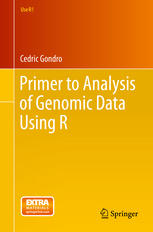Primer to Analysis of Genomic Data Using R 2015
دانلود کتاب پزشکی آغازگر برای تجزیه و تحلیل داده های ژنومی با استفاده از R.
| نویسنده |
Cedric Gondro |
|---|
| تعداد صفحهها |
270 |
|---|---|
| نوع فایل |
|
| حجم |
8 Mb |
| سال انتشار |
2015 |
89,000 تومان
از طریق این کتاب، محققان و دانشآموزان یاد میگیرند که از R برای تجزیه و تحلیل دادههای ژنومی در مقیاس بزرگ و نحوه ایجاد روالهایی برای خودکار کردن مراحل تحلیلی استفاده کنند. فلسفه پشت این کتاب این است که با مجموعه داده های خام دنیای واقعی شروع کنید و تمام مراحل تحلیلی لازم را برای رسیدن به نتایج نهایی انجام دهید. اگرچه تئوری نقش مهمی دارد، اما کتابی کاربردی برای دوره های کارشناسی ارشد و کارشناسی بیوانفورماتیک و آنالیز ژنتیکی یا برای استفاده در جلسات آزمایشگاهی است. نحوه دستکاری و مدیریت داده های ژنومی با توان عملیاتی بالا، ایجاد گردش کار خودکار، و تسریع تجزیه و تحلیل در R نیز آموزش داده شده است. طیف گسترده ای از بسته های مفید R برای کار با داده های ژنومی با مثال های عملی نشان داده شده است.
موضوعات اصلی تحت پوشش عبارتند از مطالعات ارتباطی، پیشبینی ژنتیکی، تخمین پارامترهای ژنتیکی و تنوع جمعیت، تجزیه و تحلیل بیان ژن، حاشیهنویسی عملکردی نتایج با استفاده از پایگاههای داده در دسترس عموم، و نحوه کار موثر در R با استفاده از مجموعه دادههای ژنومی بزرگ. . اصول مهم از طریق مثال های جذابی که خواننده را به کار با مجموعه داده های موجود دعوت می کند، نشان داده و نشان داده می شود. برخی از روش های مورد بحث در این جلد عبارتند از: امضای انتخاب، ضرایب جمعیت (LD، FST، FIS، و غیره). استفاده از یک ماتریس رابطه ژنومی برای مطالعات تنوع جمعیت. استفاده از داده های SNP برای آزمایش شجره نامه؛ snpBLUP و gBLUP برای پیش بینی ژن. گام به گام، تمام کدهای R مورد نیاز برای یک مطالعه ارتباطی در سطح ژنوم نشان داده میشوند: شروع با دادههای خام SNP، نحوه ایجاد پایگاههای اطلاعاتی برای مدیریت و مدیریت دادهها، روشهای کنترل کیفیت و فیلتر، آزمایش ارتباط، و ارزیابی نتیجه، از طریق شناسایی ژن های کاندید و حاشیه نویسی عملکردی آنها به طور مشابه، تجزیه و تحلیل بیان ژن با استفاده از داده های ریزآرایه و RNAseq نشان داده شده است.
در زمانی که داده های ژنومی به طور قطعی بزرگ است، مهارت های این کتاب بسیار مهم است. در سالهای اخیر، R علاوه بر نقش برجسته آن در تجزیه و تحلیل دادههای ژنومی، به ابزار واقعی برای تجزیه و تحلیل دادههای بیان ژن تبدیل شده است. مزایای استفاده از R شامل محیط توسعه یکپارچه برای تجزیه و تحلیل، انعطاف پذیری و کنترل بر گردش کار تحلیلی است. موضوعات ارائه شده مؤلفه های اصلی کلاس های پیشرفته کارشناسی و کارشناسی ارشد در بیوانفورماتیک، ژنومیک و ژنتیک آماری است. این کتاب همچنین برای استفاده توسط دانشجویان علوم کامپیوتر و آمار طراحی شده است که می خواهند جنبه های عملی تجزیه و تحلیل ژنومی را بدون پرداختن به جزئیات محاسباتی بیاموزند. مجموعه داده های مورد استفاده در سراسر کتاب را می توان از وب سایت ناشر دانلود کرد.
Through this book, researchers and students will learn to use R for analysis of large-scale genomic data and how to create routines to automate analytical steps. The philosophy behind the book is to start with real world raw datasets and perform all the analytical steps needed to reach final results. Though theory plays an important role, this is a practical book for graduate and undergraduate courses in bioinformatics and genomic analysis or for use in lab sessions. How to handle and manage high-throughput genomic data, create automated workflows and speed up analyses in R is also taught. A wide range of R packages useful for working with genomic data are illustrated with practical examples.
The key topics covered are association studies, genomic prediction, estimation of population genetic parameters and diversity, gene expression analysis, functional annotation of results using publically available databases and how to work efficiently in R with large genomic datasets. Important principles are demonstrated and illustrated through engaging examples which invite the reader to work with the provided datasets. Some methods that are discussed in this volume include: signatures of selection, population parameters (LD, FST, FIS, etc); use of a genomic relationship matrix for population diversity studies; use of SNP data for parentage testing; snpBLUP and gBLUP for genomic prediction. Step-by-step, all the R code required for a genome-wide association study is shown: starting from raw SNP data, how to build databases to handle and manage the data, quality control and filtering measures, association testing and evaluation of results, through to identification and functional annotation of candidate genes. Similarly, gene expression analyses are shown using microarray and RNAseq data.
At a time when genomic data is decidedly big, the skills from this book are critical. In recent years R has become the de facto tool for analysis of gene expression data, in addition to its prominent role in analysis of genomic data. Benefits to using R include the integrated development environment for analysis, flexibility and control of the analytic workflow. Included topics are core components of advanced undergraduate and graduate classes in bioinformatics, genomics and statistical genetics. This book is also designed to be used by students in computer science and statistics who want to learn the practical aspects of genomic analysis without delving into algorithmic details. The datasets used throughout the book may be downloaded from the publisher’s website.




